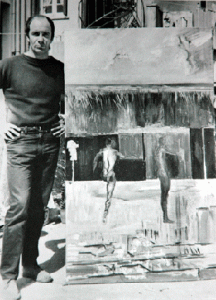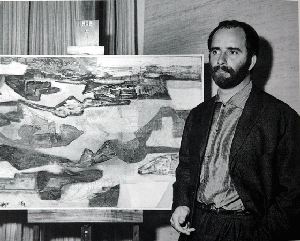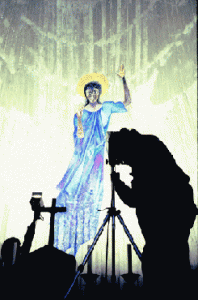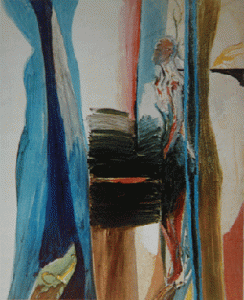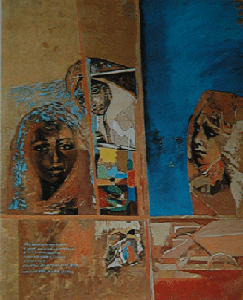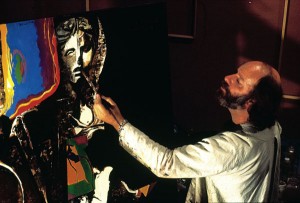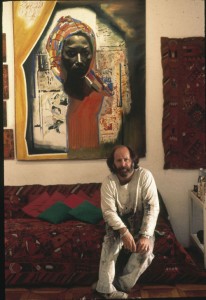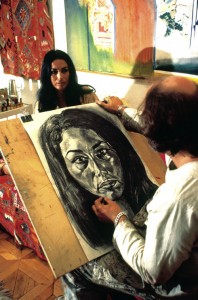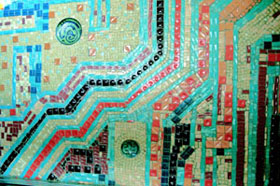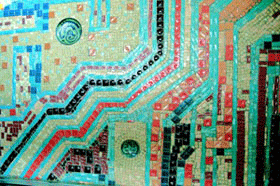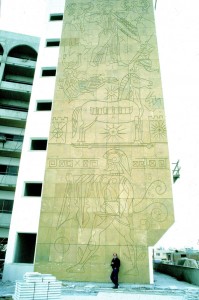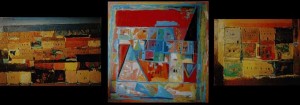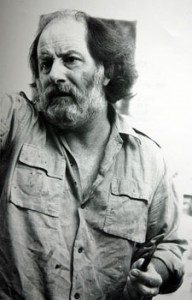1935 John was born in Sheffield, England, on February 3rd. A natural predisposition for painting was obvious at a very early age. At the age of five, one of his paintings was selected and exhibited at Burlington House, London. The influence is evident in his early work of the romantic landscape of hillsides and lakes of Derbyshire where he grew up in the village of Loxley, which, according to legend, was once part of the Forest of Sherwood. He attended school in Glasgow and later, in Elstree, London where visits to the local film studios fired his imagination.1944 He attended the junior department of the Sheffield College of Arts. 1951 He attended the Sheffield College of Arts and Crafts where he was greatly influenced by the former Prix de Rome scholar, Eric Jones, his tutor, for years, who gave him his passion for Italian art. He exhibited in group shows such as “Northern Young Artists”, where one of his paintings was purchased by the famous Manchester artist, L.S. Lowry.
1955 He visited France with fellow students and extensively studied great European art. 1956 He was awarded a Degree in Fine Art and left for Italy. He lived and worked in a variety of jobs in Ventimiglia, Menton and the south of France. He began teaching painting in outdoor classes during the summers in central Italy. He succeeded in earning a livelihood from his art and began exhibiting successfully in important group shows in Italy alongside artists of national and international standing and earned high praise an recognition. 1957 He taught at summer classes and exhibited at group shows in Ancona and the surrounding area. He held his first one-man show at Macerata in Italy which attracted a great consensus of local critics. 1958 He continued teaching summer classes and held in second show in Macerata.
1960 He held a one-man show at the Gallery Antares, Rome. The important Roman critic Michele Biancale wrote: Corbidge, who has painted during extensive travels, has succeeded in elevating his art in such a dignified way as to give it the appearance of a blend of recent aesthetic trends seen through a filter. His art could be called abstract if there wasn’t this persistent naturalistic sub-stratum betraying reality’s presence. A reality which is in this case vividly portrayed and enriched by a deep vein of poetry. This is very apparent in his use of color, which reveals the various moods of the artist. His work is impregnated with a sort of insistent realism which is in direct contrast to one’s first impression. The diversity of the combination of colors and compositions reveal Corbidge’s great agility and freedom, obviously the result of that rare gift, an inner world full of poetic instinct.He went again to Cyprus to work for a show at the Chemerinsky Gallery, Tel-Aviv. He held a further one at the Comedy Gallery, London. The world famous critic Eric Newton wrote in “The Guardian” amongst other things: not often does an artist who is both unfamiliar and personal strike one as brilliant at the first sight. But the wind that stirs the trees and tumbles the clouds all over Corbidge’s skies, the heaving restless movements of mountains, the sense of growth and turbulence, all these are what make brilliant the right word for his paintings. They have an enchanting freshness and exuberance that comes very near to the happiest of Kokoschka’s landscapes. He was invited by the then curator of the Cyprus Museum in Nicosia, the late Porphyrios Dikaios, to stage retrospective show of his work to date. For the first time the Cypriot public came into contact with personal form of abstract impressionism.
1961 Still in Cyprus, he was invited to stage at the Gallery Harmouche, Beirut. He also executed mosaics and bas-reliefs in Limassol and held a one-man show at Limassol Town Hall. 1962 He held a further show in Limassol Town Hall, then at Larnaca, at Famagusta and at the Gh. S. Apophasis Gallery in Nicosia. He also held a second one-man show at the Comedy Gallery, London. He travelled in Europe. Following his one-man show exhibition at the Drian Galleris, London, art critic Bettina Wadia wrote in “The Arts Review”: Flight, the isolated episode that is also the concentration of past and present, movement arrested be the brushstroke the also points to future displacement, figures in a landscape that is also an abstraction – Corbidge’s recent paintings all of these. They are the painter’s equivalent of Fellini’s shuttling, superimposed images or Durrell’s tangents of time off the single circle of drama. Each painting has its own tempo. So much painting has been reduced to interesting technical experiments in pure form and color. Corbidge is obviously capable of turning out the same kind of thing, but in changing from a the romantic, lyrical abstraction of two years ago to the human figure se in the landscape of abstraction, his painting has become a profound comment on human experience; As the only representational elements, the figures are distinct, but in color and adumbrated form they are completely involved in the setting. Isolated and yet strangely related to one another, the give a haunting emotional quality to these paintings. 1964 He lived for a while in London but nostalgia for the Mediterranean was overwhelming. The famous Greek poet Nikos Kavvadias wrote an essay on Corbidge in the “Tahidromos” magazine, a very rare journalistic exception for this very private poet. Children’s eyes can only see images and even those are upside down. The young can see, up to a point, but without discrimination. As people season they begin to see both within and without. The old can pierce the darkness. When this middle-aged seaman wants to reach to somewhere beyond his vision he closes his eyes for a while and then re-opens them. In this way people, animals and landscapes can be distinguished. Some are files away, some are hung on the wall and others are just left on the floor. This does no harm. There is nowhere like Famagusta. There is nowhere else in the world where one can face the sea, that particular sea which meets the dark sandy shore and, while suffering, endures and is enhanced with passion and insolence.
How many eyes have I encountered? I remember them for they belong to the women of a Cyprus long past. These eyes do not fade for they are the eyes of the statues. Limassol is an amiable place, Karavostasi is fierce, Kyrenia sleepless, and Paphos drowsy. The road with the casuarinas leads to Troodos and surrenders to the pine covered mountain slopes. Here stands the house built by Rimbaud which reminds me of the one that Stevenson repaired under the canes of Samoa. Last winter I was struck by a huge fresco hung on the wall of our shipping agent in Limassol. It transposed my way of seeing. Few of the waiting passengers seemed to notice it, fortunately for me, it hung way above their heads. Here, on an inconceivable scale, co-exist the birth of a journey, youth and I almost said death, but a journey has no death or old age, an can colors be inconceivable ? I could perceive in it the most of the least and I was required to add or subtract. To copy is a sin and can only be tolerated in High School. I looked again at the mural, what was missing, that which was unnecessary was hidden by the passengers who had landed from the ship “Taxiarchis” and were waiting to sail on to Australia. Their many-colored bags were crammed with hardtack. “The sailors mother was baking hardtack for her son”. « There is more inside,” said our agent, “Go and take a look”. And there in the next room was the beginning of all this. A landscape which could be interpreted without difficulty as a Neapolitan litany like those you see in the streets leading up to Vomero. It was then that I recognized the origin of the painter, not his nationality which is of little consequence.
I met the artist himself during my next visit to Cyprus. He scaled rather than climbed the ship’s ladder like a sailor, slightly annoyed that the ladder was not a rope. John Corbidge, Yannis as we now call him, born in Sheffield 28 years ago. He studied in England and Italy and began as a neo-realist by helping form the “Northern Young Artists” group. His work has already travelled to Italy, Canada, Japan, Israel and to the USA, where it has been greeted with enthusiasm be the critics Biancale and Eric Newton.
He speaks four languages including the Cypriot dialect which he speaks so well the he can easily be mistaken for a native. His first question to me at our first meeting was, “Do you know Seferis?” In his studio you will find Solomos next to Cavafis and books of the world’s poets. The eyes of Cyprus lead him on to travel to other seas. The exiled eyes of Katerina Cornaro, untouched even beyond death, they are both proud and sad just as old Titian bequeathed them to us. .
Every time the ship docks in Limassol Port he comes, bringing something with him and taking something away. The something I can only call poetry. I had forgotten that it could exist with such intensity. So much so that, when I write these lines, my pen becomes as heavy as cast-iron in my hand. (Realization that death is near). His great wish? To come to Athens during the winter and exhibit his work and then to stay on for good. To get to know, face to face, those people he has always felt he loved. Like in the Persian myths I always believed that distance was difficult to overcome, but I was wrong. Sheffield is near Matadi and Fikardou next to Munden. Art is without boundaries.

